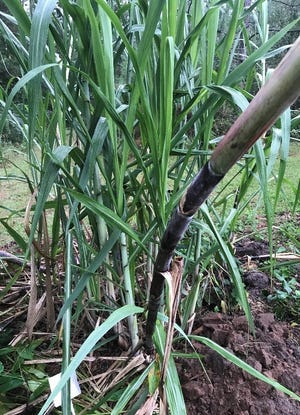How Long Does It Take for Sugarcane to Grow

Sugarcane is a perennial grass grown mainly for its juice, which is used to make sugar. The crop is grown mainly in subtropical and tropical regions, loves humid weather, and grows very fast here in north Florida.
For the most part, sugarcane is classified into three categories: crystal cane, syrup cane, and chewing cane. Crystal cane contains a high percentage of sucrose, so it is mainly used for commercial purposes to crystallize the sucrose into granular sugar. Syrup cane has less sucrose and is more fluid.

Some varieties have multi-uses, as they could be suitable for sugar production and still be great for chewing. Chewing cane is soft, with fiber that sticks together when chewed, and can also be used for making syrup.
Sugarcane is grown from what is referred to as "seed cane." This is a mature stalk with several nodes, cut two to three feet in length. Planting whole stalks is not recommended because of "apical dominance," a process in which buds closest to the cut ends tend to be activated, while interior buds might not be activated. Consequently, cutting longer stalks into shorter, six-bud seed pieces, will improve germination and plant density. Pieces with a single bud are best planted in pots as seedlings and later transplanted in the ground.
A sugarcane plant can produce several stalks each, of which can grow well over ten feet and become fully mature in about 12 to 14 months. The best time to plant is between September to November and sprouting will start in early spring.
Because a single plant will produce many stalks, it is important to keep in mind the purpose for which you are planting. A lot more plants will be needed for syrup making than for chewing. If you are planting a large plot spacing, allow 4 to 10 feet between "seed cane" stems and plant the stems horizontally, about six inches deep in a well-moistened furrow. Plant your sugarcane away from high foot-traffic areas, as the leaves can be very sharp, and some varieties tend to fall over and may become obstructive.
Sugarcane thrives best in soil with a pH of 5.5 to 6.5. Since it is in the grass family, sugar cane is a heavy feeder and thrives on nitrogen-rich fertilizers, such as a standard grass fertilizer. It likes full sun and will go dormant in winter. The main pests that threaten the plant are grubs, borers, termites, and aphids.
But since sugar cane grows fast, it has good survivability even when infested, so chemical pesticides are not usually recommended. Nuisance wildlife, such as rodents and rabbits, present a greater challenge. These usually can be controlled by installing physical barriers and placing traps.
Sugarcane is normally ready to be harvested by early November and must be completed before any killing freeze. If you harvest too early, yields will be reduced, and you may stimulate the plant to start regrowth, which will be vulnerable to winter injury.
Sugarcane juice and chewing cane can be very refreshing, and they contain antioxidants and vitamins that can help fight infections and boost your immune system. But of course, consult your physician to determine how the sugar in sugarcane may affect you.
Trevor Hylton is an Extension Agent with FAMU and UF/IFAS Extension Leon County. For gardening questions, email the extension office at AskAMasterGardener@ifas.ufl.edu.
How Long Does It Take for Sugarcane to Grow
Source: https://www.tallahassee.com/story/life/home-garden/2018/11/29/sugar-cane-grows-fast-humid-florida/2149488002/#:~:text=A%20sugarcane%20plant%20can%20produce,will%20start%20in%20early%20spring.